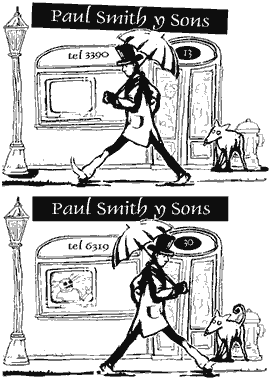TBL Framework
OUTLINE 1. Picture Puzzle: find seven differences

Ilustración: Mariano Grynberg.
The aim of this lesson outline is to illustrate a typical revision lesson covering familiar topics. The pre-task phase is, therefore, shorter than usual. This lesson also shows how a recording can be used at the end of the task cycle.
These elementary, Spanish-speaking mixed ability learners have completed the first four units of a content-based course book (addresses, family, homes, uses of numbers).
Here we go.
Pre-Task
Get learners to stand up, find a different partner from usual and sit down in their new pairs. Check they have at least one book every two. Keep them closed for now. They also need one sheet of paper every two, a pen or pencil and their language notebooks.Introduce the task Find the differences puzzle. Each learner will see both pictures. Together they have to find seven differences and write them down in note form. (Put an example on the blackboard (for example, «cat on right/on left of sign»). They will only have one minute. They should talk in English, but quietly.
Task cycle
Task
Get them ready to start: Find the picture on page... you have one minute from NOW!
Stop the task as soon as a few pairs have noted down seven differences (or when one minute is up). Ask how many differences others have found already.
Planning
Tell pairs to choose four differences they think the others many not have seen. Get them to write them down in detail, and practise explaining them, so they can tell the whole class. Show them by expanding the cat example on the board.
Go round and help, noting useful phrases and writing some on left of board, e.g. in picture A… the sign says…
Nominate the shy ones as reporters, and give them another two minutes to practise. Draw attention to phrases on the board.
Reporting and listening
Explain that they must listen carefully to other pairs. If they have the same difference, they tick it off. Once they have heard a difference, they must not report it themselves.Each pair gives one difference (write these on the board as they tell the class) till there are seven. Some pairs may still have more. Stop them from shouting them out (so they still have some to listen for later).
Announce recording of David and Bridget doing the same task.
Play the recording, Learners tick off the differences they hear. (You may need to pause after each move, and play it again.)
DAVID: Okay? Another difference is the number of the house.
BRIDGET: Yes.
DAVID: In Picture A it’s thirty; in Picture B it’s thirteen...
BRIDGET: Is thirty. Oh!
DAVID: Oh, Okay.
BRIDGET: Oh. Do you think?
DAVID: Doesn’t matter. Thirty in Picture A and thirteen...
BRIDGET: Thirteen in Picture B. And this number’s different.
DAVID: What number?
BRIDGET: The phone number of Paul Smith and Sons.
DAVID: Oh yeah. So, the phone number of Paul Smith and Sons is - what? - in Picture A- is six three one nine oh. Six three one nine oh in Picture A...
BRIDGET: Mm…
DAVID: And three three nine oh in Picture B.
BRIDGET: Okay.
DAVID: How many have we got? That’s three.
BRIDGET: Three. How many do we have to have? Seven. Mm…
DAVID: How about the television- is that on? Yes. Oh no, the television is on, is it? In the first picture.
BRIDGET: Yes, it is!
DAVID:… and it’s not on in the - in Picture B... that’s - what have we got?
BRIDGET: The television is on in Picture A but off in Picture B.
DAVID: Okay. Right. Anything else? Oh yes, the man’s carrying an umbrella.
BRIDGET: Okay.
DAVID: So what shall we put? The man…
Now ask the class if any pairs have more differences. Ask them to give one each. Tell them the total score so far is 13. Can they beat it?
Language focus
Analysis and Practice
From the blackboard:
- Learners choose a useful phrase from each sentence and practise saying it. Delete the phrase immediately as it is said. Delete other words gradually. This is called «progressive deletion» and should be fun!
- Learners read out all sentences in full, including the missing parts.
From the tapescript:
- Learners hear recording again and follow it in the tape script. Pause the tape sometimes to let them predict how the next phrase will be said (intonation with stress on key words).
- Learners read the whole transcript and find twelve questions to classify in whatever ways they like (e.g. questions with shall or get; short questions-long questions; questions with/without a verb, etcetera).
- Learners find two examples of the word so. Where does it come in the conversation?
- If there’s time, learners write down any new phrases they have noticed.
Bring the class together and review the analysis of questions. Practise short questions (point out many are without verbs) and then list questions with shall, get, have and practise them.
Practice
Make a riddle on a Small Creature, describing its physical appearance and natural capacity. Learners guess.Encourage pupils to make riddles in groups and try them on the rest of the class. Are you willing to try this plan in your class? It'd be ideal!
Bibliography
ELLIS, R. (1994). The Study of Second Language Acquisition. Oxford: Oxford University Press.RETTAROLI, S. (1999). Task-Based Learning. Applied Linguistics Association of Brazil.
SKEHAN, P. (1995). «Second Language Acquisition Research and Task-based», Instruction in: VALE, D. & FEUNTEUN, A.
WILLIS, J. (1996). A Framework for Task-Based Learning. Longman.
WILLIS, J. & WILLIS, D. (eds.) (1996). Teaching Children English. CUP.
WOODWARD, T. (1996). «Paradigm shift and the language teaching programme» in: WILLIS, J. & WILLIS, D. (eds.)
Recomendados
Building Learner Autonomy
Texto
Este texto intenta determinar cómo la competencia estratégica, lingüística y sociocultural pueden contribuir al desarrollo de una competencia comunicativa general.
Personal Factors in Language Learning
Texto
Este material tiene como objetivo que el docente haga foco en la información previa que poseen los alumnos cuando ingresan por primera vez a una clase de inglés, para que puedan determinar en qué medida esos conocimientos previos inciden en el aprendizaje de cada individuo.
The Foreign Language as a Cross-Curricular Content
Texto
El siguiente texto reflexiona sobre algunos temas básicos en la enseñanza del inglés: el establecimiento de objetivos, la selección de contenidos, la secuenciación y la evaluación.
The Process of Writing
Texto
Este material es una guía para que el docente pueda ayudar a los estudiantes a mejorar el proceso de escritura en inglés.
Evaluation and Assessment
Texto
Este material se refiere a la evaluación como parte integral del proceso de aprendizaje, y a la necesidad que existe, entre los docentes, de plantearla de ese modo.
Reading
Texto
Este material incluye sugerencias para trabajar la enseñanza de la lectura a partir de diferentes unidades lingüísticas con distintos grados de complejidad sintáctica.
Planning a Unit of Work
Texto
Este material explica cómo planificar una unidad, teniendo en cuenta dudas y dilemas. Fue escrito luego de identificar necesidades, temas e intereses y con el objetivo de poder clasificar el material lingüístico.
An Optimal [Functional] Sequencing
Texto
Este material se enfoca en la nivelación, que es la relación existente entre los procesos de aprendizaje y adquisición, y en cómo los libros de textos organizan el material de comunicación lingüística y comunicativa para facilitar el proceso de aprendizaje. En inglés.
More on Text Types
Texto
Este material se refiere a los nuevos tipos de texto y sus características, en especial aquellos relacionados con la web.
Reflective Teaching
Texto
Este material considera los beneficios de la reflexión a la hora de planear las clases, con el objetivo de mejorar los métodos de enseñanza.
Linguistic Skills and Communicative Abilities
Texto
Este material presenta las diferencias que existen entre las competencias lingüísticas y las habilidades comunicativas, la manera en que interactúan y el valor de cada una de ellas.
Knowledge Previous to the Learning Task
Texto
Esta adaptación de un texto de Earl Stevick presenta un esquema de trabajo que permite relacionar la forma en que percibimos el mundo con las habilidades y procesos necesarios para adquirir una lengua extranjera.
Multiple Intelligences at Schools
Texto
Este material, basado en la teoría de las inteligencias múltiples de Howard Gardner, plantea una reflexión sobre las implicancias de aprender una lengua extranjera.
A Task-Based Approach
Texto
El siguiente texto analiza las características de tres tipos diferentes de tareas para utilizar con los alumnos en la clase de inglés.
Stumbling Blocks in the Learning Process
Texto
El siguiente texto profundiza los conceptos del recurso "Interlanguage", analizando estrategias para superar dificultades en el proceso de aprendizaje del inglés, sobre todo las que plantea el interlenguaje.
A Task-Based Content-Based Approach
Texto
El siguiente texto analiza los beneficios de trabajar en la clase de inglés a partir de contenidos y consignas que tengan sentido en la vida y la cultura de los alumnos.
Interlanguage
Texto
El siguiente texto analiza un problema habitual en el proceso de enseñanza y aprendizaje del inglés y es el que plantea la relación con la lengua madre de quien aprende.
Materials
Texto
Este material analiza el uso de distintos materiales (libros de textos, audios de canciones o diálogos, videos y cuadernillos de actividades) para enseñar a los alumnos a comunicarse en inglés.
Foreign Language Acquisition and Learning
Texto
En este material se abordan las diferentes maneras en que se puede aprender el idioma inglés, y los factores que están en juego durante su enseñanza y aprendizaje. En inglés.
More of the Same: Why Learn More English?
Texto
Este material explica la necesidad y utilidad de seguir aprendiendo inglés en el nivel secundario.
Ficha
Publicado: 14 de enero de 2015
Última modificación: 10 de febrero de 2015
Audiencia
Docentes
Área / disciplina
Lenguas Extranjeras
Nivel
Secundario
Categoría
Material pedagógico
Modalidad
Todas
Formato
Texto
Etiquetas
inglés
estrategia de aprendizaje
lenguaje
Autor/es
Educ.ar
Licencia
Creative Commons: Atribución – No Comercial – Compartir Igual (by-nc-sa)
